| World Cup | Ball | Manufacture | Additional information | Refs |
| 1930 | Tiento (1st half)
T-Model (2nd half) |  Tiento Tiento 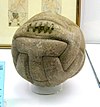 T-Model T-Model | — | Two different balls were used in the final: Argentina supplied the first-half ball (the 'Tiento') and led 2–1 at the break; hosts Uruguay supplied the second-half ball (the 'T-Model' which was larger and heavier)[4] and won 4–2. | [4] [5] |
| 1934 | Federale 102 | 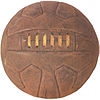 | ECAS
(Ente Centrale Approvvigionamento Sportivi), Rome | | [6] |
| 1938 | Allen |  | Allen, Paris | Made up of leather, consisted of 13 panels and had white cotton laces on a separate, thin panel. | [7] |
| 1950 | Duplo T | 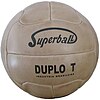 | Superball | First ball to have no laces and introduce the syringe valve. | [8] |
| 1954 | Swiss World Champion | 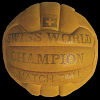 | Kost Sport, Basel | The first 18-panel ball. | [5] [9] |
| 1958 | Top Star | 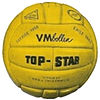 | Sydsvenska Läder och Remfabriken, Ängelholm
(aka "Remmen" or "Sydläder") | Chosen from 102 candidates in a blind test by four FIFA officials. | [10] [11] |
| 1962 | Crack | 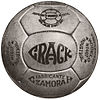 | Señor Custodio Zamora H.,
San Miguel, Chile Remmen | The Crack was the official ball. Referee Ken Aston was unimpressed with the Chilean ball provided for the opening match, and sent for a European ball, which arrived in the second half. Various matches used different balls, with the apparent rumour the European teams didn't trust the locally produced ball.[4] | [4] [5] [10] [12] |
| 1966 | Challenge 4-Star | 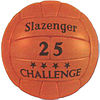 | Slazenger | 18-panel ball in orange or yellow. Selected in a blind test at the Football Association headquarters in Soho Square. | [5] [13] |
| 1970 | Telstar |  | Adidas | Telstar was the first 32-panel black-and-white ball used in the FIFA World Cup finals. Only 20 were supplied by Adidas. A brown ball (Germany-Peru) and a white ball (first half of Italy-Germany) were used in some matches. | [5] [14] |
| 1974 | Telstar Durlast | 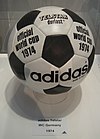 | Adidas | The first polyurethane coated ball, making it waterproof and resistant to wear and tear. | [5] |
| 1978 | Tango |  | Adidas | The first of a family of footballs that was also used in the UEFA European Championships and the Summer Olympics until 1988. | [5] |
| 1982 | Tango España |  | Adidas | Similar to its predecessor the Tango the Tango España had a polyurethane coating. It had new and improved rubberized seams and was the last leather ball to be used in the World Cup. | [5] |
| 1986 | Azteca |  | Adidas | First fully synthetic FIFA World Cup ball and first hand-sewed ball | [5] |
| 1990 | Etrusco Unico | 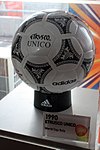 | Adidas | | [5] |
| 1994 | Questra[15] |  | Adidas | | [5] |
| 1998 | Tricolore | 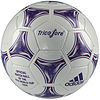 | Adidas | First multi-coloured ball at a World Cup finals tournament. | [5] |
| 1999 (women) | Icon | | Adidas | First ball specifically created for a Women's World Cup. Technically identical to the Tricolore, but with a different visual design. | [16] [17] |
| 2002 | Fevernova |  | Adidas | First World Cup ball with a triangular design. The ball for the 2003 Women's World Cup was technically identical to the Fevernova, but had a different visual design.[18] | [5] |
| 2006 | Teamgeist |  | Adidas | The Teamgeist is a 14-panel ball. Each match at the World Cup finals had its own individual ball, printed with the date of the match, the stadium and the team names.[19] A special variant, the gold-coloured Teamgeist Berlin, was used in the final match. As in 2003, the ball used for the 2007 Women's World Cup was identical in performance to the ball used in the previous year's World Cup, but with a different visual design.[20] | [5] |
| Teamgeist Berlin |  |
| 2010 | Jabulani |  | Adidas | This ball has 8 panels. A special variant was used for the final match, the gold Jo'bulani (picture on the left), which was named after "Jo'burg", a standard South African nickname for Johannesburg, site of the final game. The ball was notable for the controversy it attracted, with players and fans contending that its aerodynamics were unusually unpredictable. | [5] [21] |
| Jo'bulani |  |
| 2011 (women) | SpeedCell | | Adidas | Technically identical to the Jabulani, but with a different visual design. | [22] |
| 2014 | Brazuca |  | Adidas | This is the first FIFA World Cup ball named by the fans. The ball has been made of six polyurethane panels which have been thermally bonded. For the final game, a different colour scheme was used, featuring green, gold and black. | [23] |
| Brazuca Final Rio |  |
| 2015 (women) | Conext15 | | Adidas | Based on the technology introduced in the Brazuca. The Conext15 Final Vancouver is the first ball created specifically for a Women's World Cup Final. | [24] |
| Conext15 Final Vancouver | |
| 2018 | Telstar 18 |  | Adidas | For the 48 matches in the Group Stage, teams competed with a ball designed in tribute to the original Adidas Telstar, used in the 1970 and 1974 World Cups.[25] | [26] |
| Telstar Mechta |  | At the end of the 2018 World Cup group stage, FIFA revealed a new color scheme to be used for the 16 matches played in the Knockout Stage: the Telstar Mechta (Мечта). Mechta means 'dream' or 'ambition' in Russian. | [27] |
| 2019 (women) | Conext19 | | Adidas | Used for 36 matches in the group stage. It shares the same seamless, mono-panel design as the Telstar 18, but with a glitched graphic that's inspired by the Tricolore ball that was used in the 1998 World Cup.[28] | [29] |
| Tricolore 19 | | Inspired by the Tricolore ball and based on the same template as the Conext 19, the Tricolore 19 ball features a mono-panel aesthetic with a blue-and-red glitch graphic. This ball was used in the knockout stage. |
| 2022 | Al Rihla | | Adidas | The ball was designed with sustainability as a priority, making it the first ever official match ball created with water-based glues and inks. The name of the ball, Al Rihla, means 'the journey' or 'the excursion' in Arabic. | |
 Tiento
Tiento  T-Model
T-Model 























0 Response to "Soccer Ball Blue and Orange No Brand Name No Logo"
Post a Comment